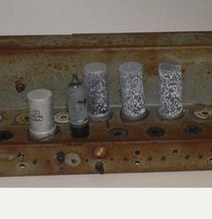| EDSAC Chassis Rediscovered |
| Written by Sue Gee | |||
| Tuesday, 17 February 2015 | |||
|
An original chassis from EDSAC, one of the world's earliest computers, has come to light in the USA and been donated to the UK National Museum of Computing where reconstruction of the 1940s machine is taking place. Although we now consider early computers as something worth preserving, this is with the benefit of hindsight. When EDSAC, the Electronic Delay Storage Automatic Calculator, built immediately after World War II by a team led by Sir Maurice Wilkes in the Mathematical Laboratory of the University of Cambridge. came to the end of its working life it was decommissioned and scrapped without any concerns about its heritage value. As a result the EDSAC Reconstruction Project had almost no original parts to work with and instead has had to rely on replica parts.
The project is also hampered by patchy documentary evidence although last year some early original EDSAC circuit diagrams were rediscovered and donated to the reconstruction team. The part that has now been handed over is a chassis 1A which in its time would have accommodated 28 of the 3000 EDSAC valves.
The chassis were a vital component of EDSAC. Built in modular fashion, EDSAC had 12 vertical racks which could hold up to 14 individual horizontal chassis. Each chassis provided all or part of one of EDSAC’s logically distinct functional units. There were about 70 different types of chassis. Some were represented only once while others were replicated. Chassis type 1A is a Storage Regeneration Unit that keeps data recirculating through a short or long tank. There were 42 identical Store Regeneration Units.
Maurice Wilkes with an EDSAC chassis
The donation comes from Robert Little, from Allentown, Pennsylvania, USA, who had read about the EDSAC reconstruction project at TNMOC. He had obtained the part in 1969 from Dr Robert E Clark, a resident of Cambridge, who had bought bought three or four EDSAC racks with the intention of converting them into bookshelves at an auction of EDSAC parts in the 1950s. Robert Little recalls that Dr Clark described how he was bidding against the local scrap metal dealer when he won the EDSAC parts, The fact that there had been an auction gives a glimmer of hope that other original parts of EDSAC might still be extant. Andrew Herbert, leader of the EDSAC reconstruction project at TNMOC, said: "We would very much like to know if more of these chassis have survived. We think that as many as 42 of this type existed in the original machine. When EDSAC was decommissioned, only three chassis were thought to be in existence – one in the Cambridge University Computer Laboratory (since loaned to The National Museum of Computing), one in the London Science Museum and one in the Computer History Museum in Silicon Valley. This is the first time any of our Project Team has heard of the auction and it's tantalising to think that more parts of the original EDSAC might be out there – somewhere! It is also exciting to think that we may have stumbled across the first computer auction!" Referring to the example that has been donated Andrew Herbert said: "Chassis 1A is quite distressed with corrosion and much of the wiring has broken away from tag strips. It would be a major task to return this particular chassis to operating condition. However, we hope to try to use some of the valves, if they are still functional, in our reconstructed EDSAC thus providing a very tangible connection with the original machine.
Having some original parts would be a great boost for the project. For health and safety reasons is having to sacrifice authenticity in building the replica. So while the original EDSAC used mercury-filled tubes for memory an alternative non-toxic substance in being used in the rebuild.
More InformationDiscovery of rare part of early computer Related ArticlesEDSAC Display Officially Opened EDSAC Reconstruction Demoed To Celebrate Wilkes Centenary On this day in 1949 - EDSAC performs stored-program calculation
Comments
or email your comment to: comments@i-programmer.info |
|||
| Last Updated ( Tuesday, 17 February 2015 ) |






